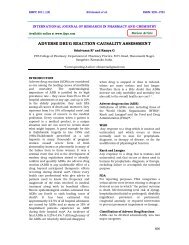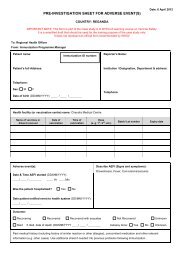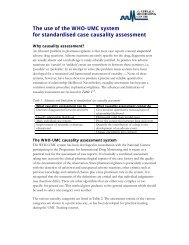00050
You also want an ePaper? Increase the reach of your titles
YUMPU automatically turns print PDFs into web optimized ePapers that Google loves.
IJRPC 2011, 1(3) Srinivasan et al. ISSN: 22312781<br />
Type A and Type B (Table 1).<br />
Type A reactions are common, predictable and<br />
may occur in any individual. Type B ADRs are<br />
uncommon and unpredictable and only occur<br />
in susceptible individuals 11 .<br />
Type A reactions are the most frequent and<br />
can be observed in as many as 25–45% of<br />
patients. These represent an exaggeration of<br />
the known primary and/or secondary<br />
pharmacological actions of the drug, they are<br />
dose related and could probably be avoided<br />
and/or foreseen 12 . Multi-factorial, involving<br />
not only defects at multiple gene loci but also<br />
environmental factors such as concomitant<br />
infections. Most work has focused on enzyme<br />
polymorphism in drug oxidation and<br />
conjugation as risk factors for drug toxicity but<br />
genes involved in cell repair mechanisms,<br />
elaboration of cytokines and immune<br />
responsiveness cannot be excluded to predict<br />
individual susceptibility to different forms of<br />
ADRs 12,14 . . Genetic polymorphisms are a<br />
source of variation of drug response in the<br />
human body. In relation to ADRs, most<br />
interest has centred on the involvement of<br />
pharmacokinetic factors and, in particular,<br />
drug metabolism. However, there is now<br />
increasing realization that genetic variation in<br />
drug targets (Pharmacodynamic factors) might<br />
also predispose to ADRs, although research<br />
into this area is in its infancy 15 .<br />
Mechanism by which ADR Occurs 16<br />
ADRs can be classified as either<br />
pharmacological reactions representing an<br />
augmentation of the known pharmacological<br />
actions of the drug or idiosyncratic reactions<br />
that are not predictable. Pharmacological<br />
reactions are most common, usually doserelated<br />
and are due to the primary or<br />
secondary pharmacological characteristics of<br />
the drug. Factors that predispose to these<br />
ADRs include dose, pharmaceutical variation<br />
in drug formulation, pharmacokinetic or<br />
pharmacodynamic abnormalities, and drugdrug<br />
interactions. Pharmacological ADRs<br />
occur when drug concentration in plasma or<br />
tissue exceeds the “therapeutic window” or<br />
when there is increased sensitivity to the drug<br />
(even in concentrations considered normal for<br />
the general population). Idiosyncratic ADRs<br />
are less common, often serious, not dose<br />
dependent and show no simple relationship<br />
between the dose and the occurrence of<br />
toxicity or the severity of the reaction. The<br />
toxic reactions may affect many organ systems<br />
either in isolation or combination. The<br />
mechanism of these is not clear but is thought<br />
to include receptor abnormality, abnormality<br />
of a biological system that is unmasked by the<br />
drug, immunological response, drug-drug<br />
interactions, or be multi-factorial.<br />
Adverse drug reaction (ADR) monitoring<br />
involves following steps<br />
1. Identifying adverse drug reaction<br />
(ADR).<br />
2. Assessing causality between drug and<br />
suspected reaction by using various<br />
algorithms.<br />
3. Documentation of ADR in patient’s<br />
medical records.<br />
4. Reporting serious ADRs to<br />
pharmacovigilance centres /ADR<br />
regulating authorities<br />
Identifying the Adverse Drug Reaction<br />
The ADRs produced by a certain new drug are<br />
often recognized when the medication is<br />
undergoing its phase three randomized<br />
controlled trials. Both in the USA and in the<br />
UK there is post marketing surveillance of<br />
ADRs. In the UK this involves reporting<br />
suspected ADRs to the Commission on<br />
Human Medicine using the yellow card<br />
system. In this system new or intensively<br />
monitored medicines should have all<br />
suspected ADRs reported and other medicines<br />
should have any suspected serious ADR<br />
reported. In spite of these mechanisms ADRs<br />
are vastly under reported, 17 and initial reports<br />
of adverse reactions to drugs have taken up to<br />
seven years for trends to begin to appear in the<br />
literature. Under reporting of ADRs is likely to<br />
be due to a number of reasons. Reporting is<br />
not mandatory to clinicians in the UK and so is<br />
likely to be forgotten about amongst the many<br />
other work pressures. A clinician may have<br />
problems recognizing the scenario as an ADR,<br />
because of the background symptoms of the<br />
patient’s original illness. Clinicians might also<br />
be wary of reporting an ADR, because of<br />
worries of inducing a complaint, even in this<br />
no blame culture NHS. It should be pointed<br />
out that the yellow card clearly states you do<br />
not need to be sure if it is or is not an ADR<br />
before you report it. In recognizing an ADR<br />
there are a number of important factors one is<br />
identifying those individuals in whom ADRs<br />
are most likely to occur. This includes the aged<br />
and the premature, those with liver<br />
607






